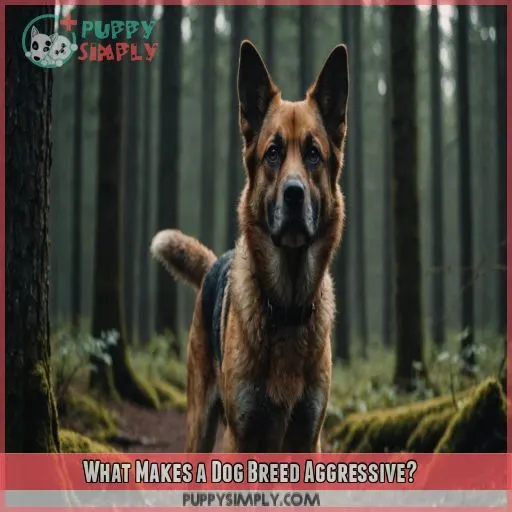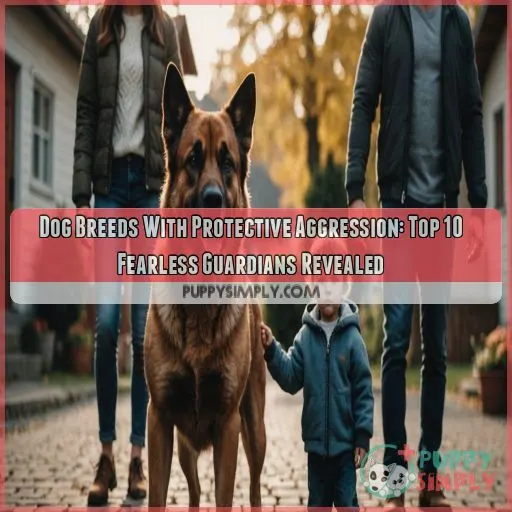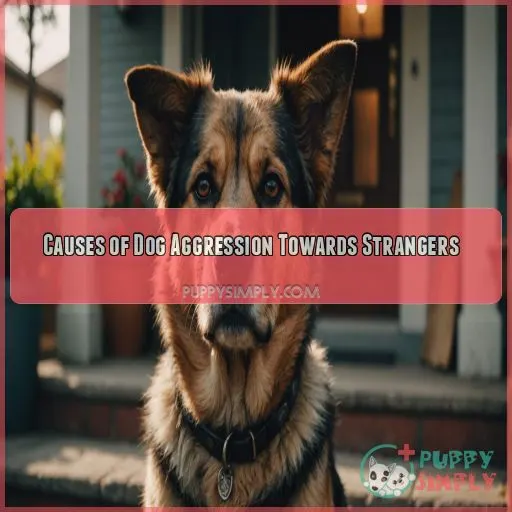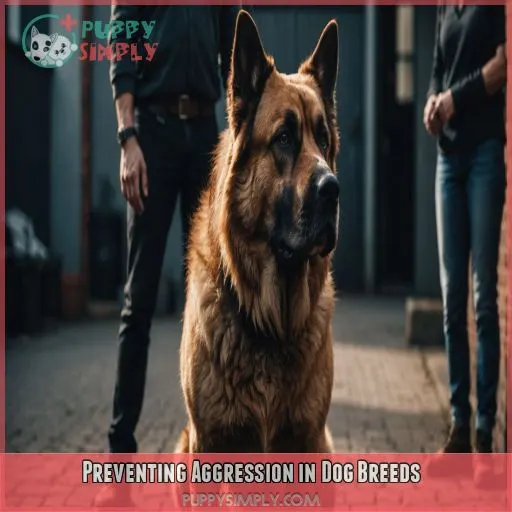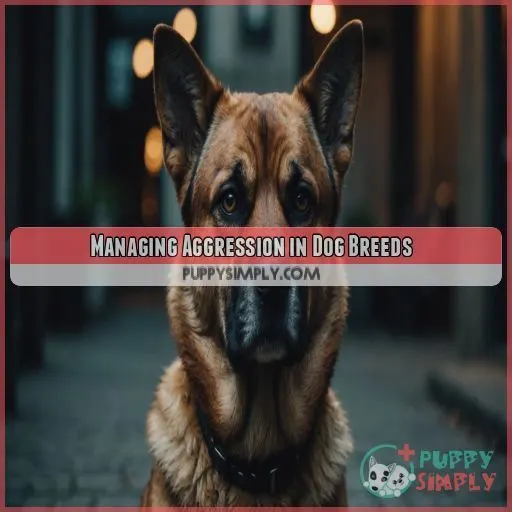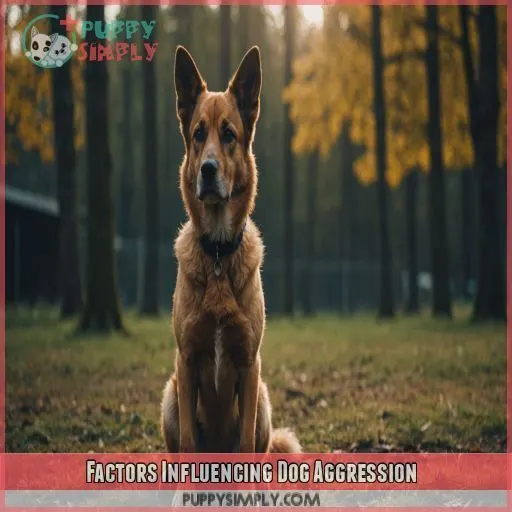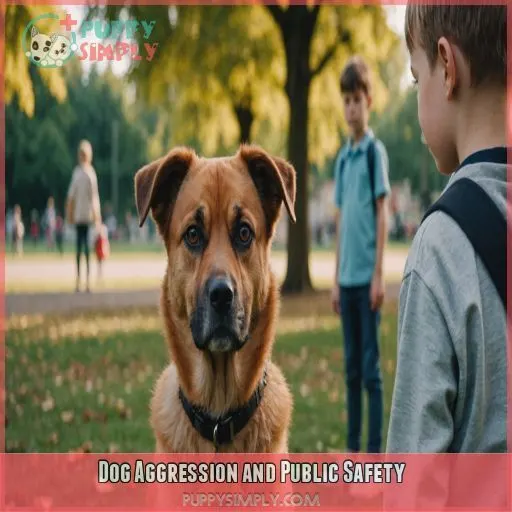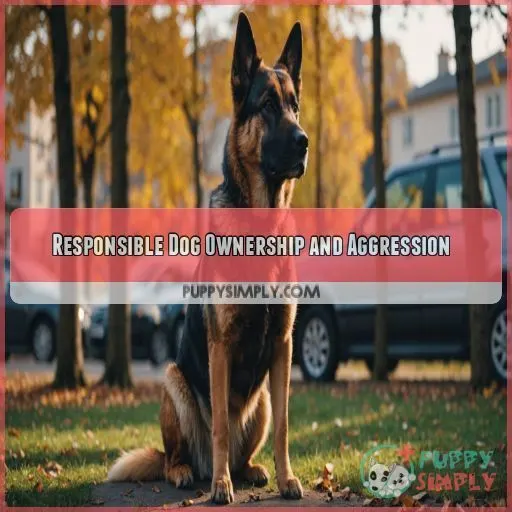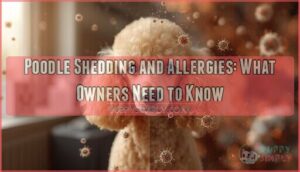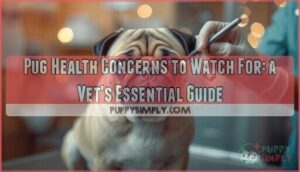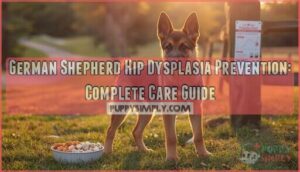This site is supported by our readers. We may earn a commission, at no cost to you, if you purchase through links.
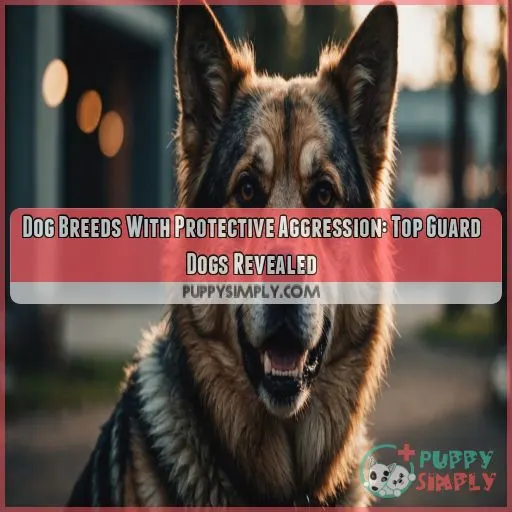
Breeds like Rottweilers, Neapolitan Mastiffs, and Presa Canarios are naturally wired to protect their families, thanks to their strong protective instincts.
With the right training and socialization, these "guard dog" breeds can make excellent companions, but they do require an experienced owner who can manage their powerful size and potential aggression when dealing with strangers.
Just remember, every dog is an individual, so it’s important to do your research and choose a breed that fits your lifestyle.
Table Of Contents
- Key Takeaways
- What Makes a Dog Breed Aggressive?
- Are Lists of Aggressive Dog Breeds Reliable?
- Dog Breeds With Protective Aggression
- Causes of Dog Aggression Towards Strangers
- Preventing Aggression in Dog Breeds
- Managing Aggression in Dog Breeds
- Factors Influencing Dog Aggression
- Reducing Aggression in High-Risk Breeds
- Dog Aggression and Public Safety
- Responsible Dog Ownership and Aggression
- Frequently Asked Questions (FAQs)
- Conclusion
Key Takeaways
- Certain dog breeds, such as Rottweilers, Neapolitan Mastiffs, and Presa Canarios, have strong protective instincts that can make them excellent guard dogs, but they require an experienced owner who can manage their powerful size and potential aggression.
- Genetics and breeding history play a significant role in a dog’s tendency towards protective aggression, but individual temperament still varies, so responsible ownership and proper training are crucial.
- Early socialization, consistent positive reinforcement training, and addressing any underlying medical issues can help curb aggressive tendencies in high-risk breeds and keep your pup a gentle giant.
- As a responsible dog owner, it is your responsibility to research breed temperaments, provide proper care and socialization, and stay on top of local laws to prevent dog bites and keep your community safe.
What Makes a Dog Breed Aggressive?
You know, just like people, some dog breeds are naturally more inclined to play the role of a protective guardian due to their genetics and strong instincts. While a Dachshund might want to chase the mailman, breeds like Rottweilers and Pitbulls often channel their energy into guarding roles, driven by their strength, size, and trainability.
Genetics and Aggression
Ever wonder why some dogs seem predisposed to bark up a storm at the first sign of trouble? It often comes down to their genetic predisposition. Breed-specific aggression happens because certain traits, like protectiveness, are inherited. Like a family recipe passed down, these traits shape canine temperament. But don’t worry—understanding their breeding history can help manage aggression.
Prey Drive and Hunting Instincts
Understanding prey drive and hunting instincts is key to managing your dog’s behavior. Some breeds naturally excel at chasing—that’s science, my friend! You can’t change biology, but you can channel it. Use toys and guided play to satisfy their instincts. A well-socialized, exercised pooch is less likely to let their wild side take control. You’re the boss, after all!
Strength and Size Factors
When thinking about aggressive dog breeds, size and strength are key factors to keep in mind. Larger breeds with powerful jaws and high bite force, like Rottweilers and Mastiffs, can pose a greater risk if their protective instincts turn aggressive. Understanding a breed’s physical capabilities is important in preventing potential dog attacks and managing these dominant behaviors.
Trainability and Behavioral Issues
While strength and size get things rolling, trainability can pack a punch in dog aggression. Imagine this: your pooch is a stubborn mule with behavioral triggers that test your nerves!
- Training challenges: Can leave you feeling like a circus trainer.
- Behavior modification: A wizardry most dog owners must tackle.
- Impact on bonding: Can be a rollercoaster.
- Owner responsibility: Essential for harmony.
Are Lists of Aggressive Dog Breeds Reliable?
You’re probably familiar with the lists of dog breeds labeled as aggressive, but they’re not always as reliable as they seem. Just like how your favorite spicy food might be too much for someone else, what makes a breed seem aggressive often depends on a mix of facts, history, and individual differences.
Public Opinion Vs. Facts
Don’t buy into breed stereotypes; they’re often fueled by media influence and owner bias. Dog behavior varies widely. Regarding protective aggression or fear aggression, no breed has a monopoly on those traits. Instead of relying on hearsay, turn to fact-checking resources and responsible reporting to understand dog breeds truly. After all, every dog’s a book, not a headline.
Breeding History and Aggression
If you’re worried about aggressive dog breeds, you can’t always trust those sensationalized lists. The truth is, a breed’s history of selective breeding for tasks like guarding or hunting plays a big role in their potential for protective aggression. But individual temperament still varies, so responsible ownership is key.
- Breeds bred for guarding or fighting tend to have higher aggression potential.
- Hunting dogs may exhibit stronger prey drives, increasing the risk of aggression.
- Careful socialization and training can help mitigate aggressive tendencies in any breed.
ATTS Testing for Temperament
Just like understanding a mystery novel’s plot twist, ATTS testing brings clarity to breed reliability. It assesses temperament traits, helping you grasp protective aggression in dog breeds. With test accuracy and ethical concerns in mind, this offers a peek into their behavioral quirks. Knowing warning signs through dog socialization lets you handle temperament hiccups smoothly. Stay safe and informed!
Individual Differences in Breeds
While ATTS testing gives insight into a breed’s temperament, remember—dogs aren’t cut from the same cloth. Individual differences? Oh, they’re real! Genetics play a part, but so does socialization and training. It’s like a leashed dog’s sudden aggression—unexpected, but understandable. Viewing every dog as unique makes handling protective aggression more like a walk in the park!
Dog Breeds With Protective Aggression
You’ve seen dogs that bark at every squirrel, but some breeds stand guard with a bit more intensity. Let’s explore dogs with natural instincts to protect their homes and families, showcasing legends like the Rottweiler and the fearless Chihuahua.
Chihuahua Temperament and Aggression
Don’t let their tiny size fool you – Chihuahuas can pack a big punch when it comes to aggression. These feisty pups often display protective and unpredictable behaviors, especially around strangers. Proper training and socialization are key to keeping their territorial tendencies in check. Always keep your Chihuahua leashed and under control to avoid any unexpected outbursts.
Rottweiler Guarding Instincts
Rottweilers were once used to guard cattle.
Today, their protective instincts make them exceptional watchdogs.
Proper socialization and guarding training can channel their protective aggression positively.
Understanding Rottweiler temperament, owner responsibility, and resource guarding is important.
Treat them with kindness, and they’ll be your steadfast guardians, ready to defend their territory at a moment’s notice.
Pitbull Terrier Fighting History
Rottweilers aren’t the only protective powerhouses. Meet the Pitbull Terrier, a breed with a controversial fighting history that evolved into a loyal companion. Not all pit bulls fit the "fighting dog" stereotype. Many modern advocates support their gentle side and stress training for dog safety. Amidst breed standards and legislation, these dogs shine with proper care and guidance.
Neapolitan Mastiff Protective Nature
Consider the Neapolitan Mastiff, a powerhouse with guarding instincts that would put a castle to shame.
This breed’s temperament blends protectiveness with loyalty, demanding effective training methods.
Mastiff owners should focus on socialization tips early, ensuring friends aren’t mistaken for foes.
Think of them as furry doormen, cautioning strangers entering your home—a big love bug wrapped in a serious security package!
Presa Canario Guarding Abilities
As a powerful guardian breed, the Presa Canario’s guarding abilities aren’t to be underestimated. This imposing dog, with its muscular build and fierce loyalty, has a long history of protecting its family and property. To harness the Presa Canario’s protective instincts, proper training, socialization, and responsible ownership are essential for ensuring both safety and companionship.
- Formidable size and strength
- Unwavering devotion to its pack
- Innate guarding and territorial instincts
Causes of Dog Aggression Towards Strangers
Ever wondered why some dogs just bark harder at strangers than others? It’s often in their genes, especially when you add in a stubborn streak or a touch of "I’m the boss" attitude—and don’t get me started on the grumpiness of intact males with a sore paw!
Genetics and Breed Tendencies
In the world of dog breeds, genetics often pull the strings behind aggression like a master puppeteer. Selective breeding has nurtured certain traits, turning some breeds into protectors while making others unsuitable for households seeking companionship over courage. Understanding these inherited tendencies helps you choose wisely, balancing your desire for a furry friend with behaviors that suit your lifestyle.
Intact Male Dogs and Aggression
When your furry friend stays intact, testosterone levels can stir things up, sometimes leading to protective aggression around strangers. While that raised hackles might seem brave, behavioral changes through neutering offer peace of mind. Owner responsibility is key; understanding breed differences and working with a veterinary behaviorist can help you navigate this terrain. A little liability insurance wouldn’t hurt either!
Medical Conditions Triggering Aggression
Beneath the surface, certain medical conditions can trigger a dog’s protective instincts and lead to aggressive behaviors. From painful arthritis to dental infections, any source of discomfort may cause your pup to lash out defensively. Be on the lookout for:
- Endocrine disorders like thyroid disease
- Neurological conditions like steroid responsive meningitis
- Chronic pain from joint or muscle issues
Addressing these underlying health concerns through veterinary care and anti-anxiety medications can help curb aggressive outbursts and keep your canine companion feeling safe and secure.
Preventing Aggression in Dog Breeds
Preventing aggression in dog breeds doesn’t have to be rocket science; start by socializing your pup early, ensuring they see more faces than just yours. Consistent training with a sprinkle of patience and a whole lot of love can turn potential snarls into wagging tails.
Early Socialization for Puppies
Spotting potential triggers for aggression in dog breeds, like strangers, calls for action. Early socialization’s the secret sauce; it’s like puppy playdates but with a purpose! This critical window (3-16 weeks) is pure gold. Socialization benefits include fear prevention and understanding body language. Don’t use physical barriers; instead, seek help from a certified applied animal behaviorist.
Consistent Training for Good Behavior
After early socialization, consistent training for good behavior is your secret weapon. Keep it lighthearted with positive reinforcement—your dog loves rewards, after all! Embrace a routine to master those tricky behaviors. Remember, consistency is key:
- Laugh off mistakes: Dogs aren’t perfect!
- Celebrate successes: Treats are gold.
- Seek professional guidance: We’re all learning, right?
Arm yourself with patience and persistence!
Neutering and Reducing Aggression
Neutering your pup can be a game-changer for curbing aggressive tendencies. Testosterone fuels many undesirable behaviors, so snipping those hormones can work wonders. Just remember, neutering alone won’t fix everything – consistent training and proper management are still key to keeping your canine companion’s aggression in check.
Adequate Exercise and Mental Stimulation
You’ve got a furry friend who’s just itching for a run! Adequate exercise does wonders for managing energy in protective breeds, helping nip aggression in the bud. Think of dog enrichment like a brain workout—puzzles and toys prevent boredom and combat protective aggression. Keeping the mind sharp and body active is key for dog care and mental stimulation.
Managing Aggression in Dog Breeds
When dealing with a dog’s protective aggression, it’s important to watch for behavior changes like growling, as addressing issues early prevents bigger problems later. Consulting a professional or using positive reinforcement training can turn the growl of a guard dog into a gentle giant’s whisper, leaving everyone wagging their tails.
Recognizing Signs of Aggression
Spotting signs of protective aggression in dogs can keep everyone safe. Look for these telltale signs—consider them the dog’s "I’m not happy" signals:
- Body language: Stiff posture or lowered head.
- Growling: An obvious warning.
- Lip licking: Checking out the situation, or just lunch remnants?
- Tail tucking: Fear or uncertainty.
- Whale eye: Eyes wide, whites showing.
Engage with these cues, and you’re halfway to dog whisperer status!
Consulting Professionals for Help
If your dog’s aggression persists despite your best efforts, don’t hesitate to consult a professional. Certified dog trainers and animal behaviorists have the expertise to identify the root causes and develop a customized intervention plan. Their guidance can make all the difference in managing your pup’s protective aggression safely and effectively.
| Certified Specialists | Ethical Training |
|---|---|
| Experienced Trainers | Positive Reinforcement |
| Behavioral Assessments | Customized Interventions |
| Aggression Intervention | Ongoing Support |
Positive Reinforcement Training Methods
Imagine turning your dog’s mansion into a kindergarten! Use rewards-based training and clicker training to shape behavior gently. Think of treats as little gold stars. Positive reinforcement techniques transform your pooch into a scholar of good manners. Keep baby gates and pet-proof trash cans handy for curious critters; even dog breeds for fighting can transform with consistent praise and jamboree.
Managing Fear and Anxiety in Dogs
You’ve mastered positive reinforcement, but fear-based aggression is pesky.
Think of wrinkled muzzles as storm clouds – temporary but looming.
Separation anxiety can spark behaviors like noise-induced jitters.
Use calming techniques and enrichment activities to soothe nerves.
Look for ear infections or brain disorders; they’re pesky anxiety triggers.
Consider pet insurance to curb poor health oversight.
Safety brings peace of mind.
Factors Influencing Dog Aggression
If you think your dog’s aggression is unpredictable, you’re not alone—it can feel like unraveling a mystery wrapped in fur. Factors like your own behavior, their environment, medical conditions, and even a lack of socialization can make your normally loving pooch go into "guard dog" mode.
Environmental Factors and Aggression
Alongside environmental factors, your dog’s surroundings can have a big impact on their aggression. Loud noises, crowded spaces, and feeling territorial can all trigger stress and defensive behaviors. Proper socialization from a young age helps pups learn to stay calm in new situations. And addressing dental issues or ear infections that cause pain can curb aggressive outbursts.
Owner Behavior and Dog Aggression
Understanding your dog’s behavior isn’t rocket science. It’s about owner training. Consistency matters when setting boundaries. Ever seen a fearful owner walk a dog? It’s like the blind leading the blind! Inconsistent rules only confuse your furry friend. Use positive reinforcement to guide them, ensuring they feel secure and controlled. You’re the pack leader, and they trust you.
Lack of Training and Socialization
While owner behavior holds the reins, lack of training and socialization can lead to a whirlwind of trouble.
Failing to socialize your puppy effectively may result in fearful behaviors that linger like a shadow.
Start with proper training methods early for your four-legged friend.
Medical Conditions and Pain
Sometimes health concerns can sneak up faster than a squirrel on a hot summer day. Medical conditions, like pain from arthritis or dental issues, can lead to aggression in dogs.
- Monitor your dog’s health regularly
- Be aware of changes in behavior
- Consult a vet for accurate diagnosis
- Manage their pain with proper care
Keep their tails wagging and their spirits high!
Reducing Aggression in High-Risk Breeds
Certain dog breeds are more prone to protective aggression, but don’t worry – with the right training and socialization techniques, you can curb those high-risk tendencies. From managing fear and anxiety to fulfilling your responsibilities as a pet owner, we’ll walk you through effective strategies to reduce aggression in these guard dog breeds.
Training Strategies for High-Risk Breeds
You’ve navigated the choppy waters of dog aggression—now let’s tackle training strategies! Positive reinforcement is your best friend; reward good behavior over punishing the bad. Fear management helps your pup feel safe. Early intervention and owner education are key, like reading the room before a surprise birthday party. With patience, you’ll train high-risk breeds successfully!
Socialization Techniques for Aggressive Breeds
Start socializing your pup early! With aggressive breeds, it’s key to start with:
- Puppy training classes: It builds confidence and reduces fear.
- Desensitization techniques: Gradually expose them to different stimuli.
- Positive reinforcement: Reward good behavior, and watch that tail wag!
Managing Fear and Anxiety in High-Risk Breeds
When managing fear-based aggression in high-risk breeds, understand their anxiety triggers. Imagine you’re having a bad hair day—frustrating, right? Use desensitization techniques to reduce stress, just like calming signals help dogs find their Zen. Incorporate stress management methods with some quality fetch time—they’ll wag their tails and, eventually, stress less. Embrace patience and persistence with your four-legged friend!
Owner Responsibilities and Aggression Prevention
As a responsible dog owner, you play a key role in preventing aggression. Start with early socialization to build your pup’s confidence. Tailor training to your breed’s unique needs, using positive reinforcement. Manage fear and anxiety through calming techniques. With diligence and care, you can nurture a well-adjusted, non-aggressive companion.
Dog Aggression and Public Safety
When you’re walking down the street and spot a tail-wagging giant, dog aggression can seem like a distant nightmare until it isn’t. Understanding the risks and taking steps to prevent dog bites helps keep your shoelaces intact but also helps communities stay safe and friendly.
Risks of Dog Aggression to Humans
Understanding the risks of dog aggression is important, especially when dog bite statistics suggest legal liability isn’t a walk in the park. It’s barking mad how child safety can hinge on breed stereotypes, but don’t let that wag your tail. Embrace prevention strategies, fostering a pup-friendly environment where you hold the leash of understanding and control.
Preventing Dog Bites and Attacks
To curb dog bites and attacks, focus on preparation. Leash laws help keep things under control on walks—nobody wants their dog going rogue like a toddler in a candy store. Consider these three tips:
- Muzzle training: Provide safety without limiting their chatter.
- Dog bite statistics: Study them to understand patterns.
- Responsible ownership: Proper training helps harness nature’s guard.
Stay sensible, stay safe!
Community Awareness and Education
Raising community awareness and educating the public about dog aggression is really important for everyone’s safety. By understanding breed tendencies and proper pet ownership, we can work together to prevent dog bites and attacks. Attend local events, share resources, and model responsible dog handling – your actions can make a real difference.
Breed-Specific Legislation and Aggression
You might wonder if laws targeting specific breeds actually keep communities safer or just ruffle feathers with ethical concerns.
Breed-specific legislation aims to reduce incidents by focusing on breeds deemed aggressive.
However, legal challenges abound, sparking debate.
Understanding your dog’s behavior and exercising responsible ownership are key when keeping your four-legged family member within the law and your neighbors’ comfort zone.
Responsible Dog Ownership and Aggression
When choosing a dog, matching a breed’s temperament with your lifestyle can prevent headaches and hasty rehoming. Invest in a little training and love early on, and you’ll get a loyal companion who won’t mistake your mail carrier for a chew toy!
Choosing the Right Breed for Your Lifestyle
You don’t want a couch potato if you’re an active adventurer! When choosing the right dog breed for your lifestyle, consider:
- Lifestyle Fit: How energetic is your daily routine?
- Temperament Needs: Do you prefer a social butterfly or a reserved companion?
- Training Ease: Are you up for a challenge, or do you need a more obedient friend?
Keep these factors in mind!
Researching Breed Temperament and Aggression
Before bringing home a furry friend, it’s really important to research a breed’s temperament and potential for aggression. Some breeds have a stronger protective instinct, while others may be more easygoing. Dig into breed histories, consult experts, and consider your own lifestyle to find the right match. An informed decision can prevent heartache down the line.
Providing Proper Care and Socialization
Providing proper care and socialization for your dog is like planting seeds for a happy garden! Early socialization is key to avoiding challenges. Heres how:
- Puppy training starts the foundation.
- Master dog park etiquette to make sure safe play.
- Choose a breed that fits your lifestyle; responsible breeding matters.
- Tackle socialization challenges with patience and love.
Preventing Aggression Through Training and Management
Preventing aggression begins with early socialization and keeping a cool head. Try positive reinforcement—it’s your new best friend. Remember, breed-specific training isn’t just for show. It’s also important to manage fear like a seasoned captain sailing through rough seas.
| Key Factor | Action Step |
|---|---|
| Early Socialization | Introduce to diverse stimuli |
| Positive Reinforcement | Reward good behavior |
| Breed-Specific Training | Tailor exercises per breed |
Frequently Asked Questions (FAQs)
How does protective aggression in dogs manifest?
Protective aggression in dogs is like an overzealous bodyguard. Your pup might bark, growl, or even snap when they perceive a threat to their human or territory, acting out of loyalty rather than malice.
What triggers protective aggression in certain breeds?
It’s like flipping a switch when certain breeds sense a threat. Protective aggression often kicks in due to strong territorial instincts, anxiety, or past experiences, making them hyper-vigilant defenders of their family and turf (Source).
How can training reduce protective aggression?
Ah, so you think your pup’s got a bit of a protective streak, eh? No need to worry – with the right training, you can turn that guard dog into a total softie. Just shower ’em with treats, praise, and socialization, and watch that aggression melt away!
Are there legal concerns with protective breeds?
There are legal concerns with protective breeds, including breed-specific legislation and liability for aggressive incidents. You need to know your local laws, make sure you have proper training, and secure liability insurance to protect yourself and others (Source).
Can protective aggression affect dog socialization?
Imagine socializing a dog with protective aggression—it’s like teaching a stubborn cactus to dance! With patience and expert help, you’ll nurture your dog’s confidence, ensuring they’re a social butterfly, not a misunderstood porcupine.
Conclusion
Did you know that about 4.5 million dog bites occur in the U.S. each year?
This highlights the importance of understanding dog breeds with protective aggression against strangers.
Owning such breeds requires a blend of responsibility, training, and awareness.
When you choose a breed known for its guarding instincts, you’re getting a loyal companion, but also taking on the duty of managing their behavior.

